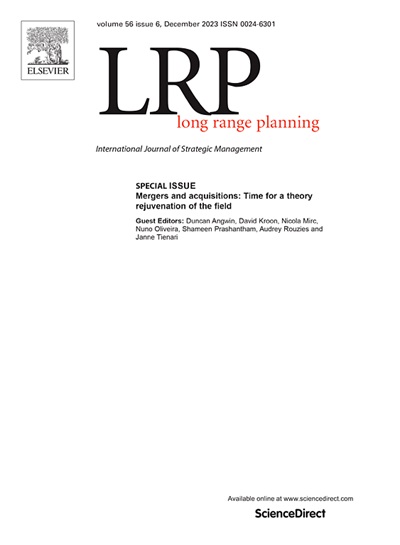从起步到成名:资源分配策略对新创企业生存和成长的影响
IF 6.3
2区 管理学
Q1 BUSINESS
引用次数: 0
摘要
关于新创企业的生存和成长的文献中有一个经久不衰的问题:为什么有些初创企业能够生存下来,而另一些却失败了?为什么某些新生公司在随后的几年里实现了快速增长,而许多公司却停滞不前?本研究探讨了保守和激进的资源配置策略如何影响这些结果。通过分析2011 - 2019年意大利44,559家公司的年度观察结果,我们发现,越激进的资源配置策略(即:如果将总资产中较大的份额分配给非金融资源,那么在早期阶段生存的可能性就越大。在成长阶段也是如此,在这个阶段,继续采用积极的资源配置策略的企业大大增加了成为高增长企业的机会。额外的分析强调了工厂、财产和设备在影响这些结果中的关键作用。我们还证明了过去的资源配置策略具有路径依赖效应。这强调了早期决策对塑造企业长期增长轨迹的重要性,因为在生存阶段的资源配置越激进,在后期阶段过渡到高增长公司的可能性就越高。本文章由计算机程序翻译,如有差异,请以英文原文为准。
From start to stardom: The impact of resource allocation strategies on new venture survival and growth
An enduring question in the survival and growth of new ventures literature is why some start-ups secure survival while others fail, and why certain nascent firms achieve rapid growth in the ensuing years while many stagnate. This study investigates how conservative and aggressive resource allocation strategies impact these outcomes. By analyzing 44,559 firm-year observations in Italy from 2011 to 2019, we find that the more aggressive the resource allocation strategies—i.e., allocating a larger share of total assets to non-financial resources—the greater the likelihood of survival in the early phase. The same holds true during the growth phase, where ventures that continue adopting aggressive resource allocation strategies significantly increase their chances of becoming high-growth firms. Additional analysis highlights the critical role of plant, property, and equipment in influencing these outcomes. We also demonstrate that past resource allocation strategies exert a path-dependence effect. This underscores the importance of early-stage decisions in shaping a venture's long-term growth trajectory, as the more aggressive the resource allocation during the survival phase, the higher the likelihood of transitioning into a high-growth firm in later stages.
求助全文
通过发布文献求助,成功后即可免费获取论文全文。
去求助
来源期刊

Long Range Planning
Multiple-
CiteScore
13.00
自引率
7.10%
发文量
75
期刊介绍:
Long Range Planning (LRP) is an internationally renowned journal specializing in the field of strategic management. Since its establishment in 1968, the journal has consistently published original research, garnering a strong reputation among academics. LRP actively encourages the submission of articles that involve empirical research and theoretical perspectives, including studies that provide critical assessments and analysis of the current state of knowledge in crucial strategic areas. The primary user base of LRP primarily comprises individuals from academic backgrounds, with the journal playing a dual role within this community. Firstly, it serves as a platform for the dissemination of research findings among academic researchers. Secondly, it serves as a channel for the transmission of ideas that can be effectively utilized in educational settings. The articles published in LRP cater to a diverse audience, including practicing managers and students in professional programs. While some articles may focus on practical applications, others may primarily target academic researchers. LRP adopts an inclusive approach to empirical research, accepting studies that draw on various methodologies such as primary survey data, archival data, case studies, and recognized approaches to data collection.
 求助内容:
求助内容: 应助结果提醒方式:
应助结果提醒方式:


